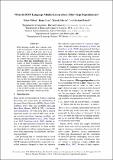| dc.contributor.author | Wilcox, Ethan | |
| dc.contributor.author | Levy, Roger | |
| dc.contributor.author | Morita, Takashi | |
| dc.contributor.author | Futrell, Richard | |
| dc.date.accessioned | 2021-11-03T14:38:32Z | |
| dc.date.available | 2021-11-03T14:38:32Z | |
| dc.date.issued | 2018 | |
| dc.identifier.uri | https://hdl.handle.net/1721.1/137202 | |
| dc.language.iso | en | |
| dc.publisher | Association for Computational Linguistics | en_US |
| dc.relation.isversionof | 10.18653/v1/w18-5423 | en_US |
| dc.rights | Creative Commons Attribution 4.0 International license | en_US |
| dc.rights.uri | https://creativecommons.org/licenses/by/4.0/ | en_US |
| dc.source | Association for Computational Linguistics | en_US |
| dc.title | What do RNN Language Models Learn about Filler–Gap Dependencies? | en_US |
| dc.type | Article | en_US |
| dc.identifier.citation | Wilcox, Ethan, Levy, Roger, Morita, Takashi and Futrell, Richard. 2018. "What do RNN Language Models Learn about Filler–Gap Dependencies?." Proceedings of the 2018 EMNLP Workshop BlackboxNLP: Analyzing and Interpreting Neural Networks for NLP. | |
| dc.contributor.department | Massachusetts Institute of Technology. Department of Brain and Cognitive Sciences | |
| dc.contributor.department | Massachusetts Institute of Technology. Department of Linguistics and Philosophy | |
| dc.relation.journal | Proceedings of the 2018 EMNLP Workshop BlackboxNLP: Analyzing and Interpreting Neural Networks for NLP | en_US |
| dc.eprint.version | Final published version | en_US |
| dc.type.uri | http://purl.org/eprint/type/ConferencePaper | en_US |
| eprint.status | http://purl.org/eprint/status/NonPeerReviewed | en_US |
| dc.date.updated | 2021-04-06T18:16:25Z | |
| dspace.orderedauthors | Wilcox, E; Levy, R; Morita, T; Futrell, R | en_US |
| dspace.date.submission | 2021-04-06T18:16:26Z | |
| mit.license | PUBLISHER_CC | |
| mit.metadata.status | Authority Work and Publication Information Needed | en_US |
